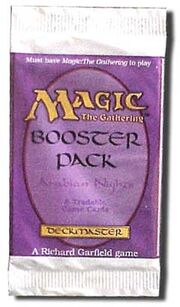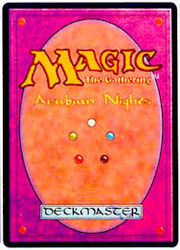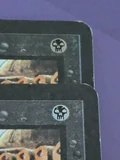Tag: Visual edit |
BlackDiamondDragon (talk | contribs) (→Strictly better: true, but we generally don't care about that for these comparisons) |
||
| Line 83: | Line 83: | ||
==Strictly better== |
==Strictly better== |
||
Cards from ''Arabian Nights'' as compared to cards from earlier sets. |
Cards from ''Arabian Nights'' as compared to cards from earlier sets. |
||
| − | * <c>Ali Baba</c>, <c>Hurr Jackal</c> and <c>Kird Ape</c> are strictly better than <c>Mons's Goblin Raiders</c> |
+ | * <c>Ali Baba</c>, <c>Hurr Jackal</c> and <c>Kird Ape</c> are strictly better than <c>Mons's Goblin Raiders</c>. |
* <c>Desert Nomads</c> is strictly better than <c>Gray Ogre</c>. |
* <c>Desert Nomads</c> is strictly better than <c>Gray Ogre</c>. |
||
* <c>Flying Men</c> is strictly better than <c>Merfolk of the Pearl Trident</c>. |
* <c>Flying Men</c> is strictly better than <c>Merfolk of the Pearl Trident</c>. |
||
Revision as of 17:39, 5 April 2021
| Arabian Nights | |||||
|---|---|---|---|---|---|
| Set Information | |||||
| Set symbol | |||||
| Symbol description | Scimitar | ||||
| Design | Richard Garfield | ||||
| Development |
Richard Garfield Joel Mick Skaff Elias | ||||
| Art direction | Jesper Myrfors | ||||
| Release date | December 17, 1993 | ||||
| Plane | Rabiah (originally Arabia, China, and other locations from "One Thousand Nights and One Night") | ||||
| Themes and mechanics |
Non-mana producing lands, meta-game effects, coin flip effects | ||||
| Set size |
78 cards (27 commons, 51 uncommons) | ||||
| Expansion code | ARN[1] | ||||
| Early non-block expansions | |||||
| |||||
| Magic: The Gathering Chronology | |||||
| |||||
- For the comic, see Arabian Nights (comic).

Arabian Nights booster
Arabian Nights is the very first Magic expansion and was released in December 1993.[2] It is not considered part of any block.
Set details
Arabian Nights was printed on sheets of 121 cards. The set's rarity breakdown is: 27 commons (1@C1, 1@C11, 9@C5, 16@C4) and 51 uncommons (1@U4, 17@U3, 33@U2).[3] Because of the relative number of uncommons to commons in a pack, C1 and U3 cards are of equal rarity, despite being printed on different sheets. Due to production difficulties,[4] 14 common cards have light or dark variants (see Misprints section below).[5] Most collectors consider these variants to be distinct cards, and therefore a full set to be 92 cards. If the light and dark variants are treated as distinct, there are 41 commons (1@C11, 4@C5, 9@C4, 10@C3, 7@C2, 10@C1). The U2 are considered the "rares" of the set.[6] Arabian Nights was designed by Richard Garfield [7] and co-developed by Joel Mick and Skaff Elias.[8] Arabian Nights is the first set to use an expansion symbol: a scimitar, meant to evoke the Arabian setting of the expansion.[4][9]
The Arabian Nights lands have a sand-colored text box, which was reused in Fourth Edition and Chronicles.
Multiple cards in this set use accent marks, or diacritics, in their names. These accents are not printed in the card title because the card title font did not support them, but can be found in the text box.
Marketing

The rejected card back for Arabian Nights
The print run was announced by Wizards to be 5 million cards. Cards were available from late December 1993 until late January 1994. They were sold in booster packs of eight cards which included six commons and two uncommons. Booster boxes contained 60 booster packs.[10] Arabian Nights booster boxes are now extremely rare and cost tens of thousands of dollars. The summer after the release, while The Dark debuted, Arabian Nights booster packs were already selling for five dollars compared to the original price of only $1.50.
As the first Magic expansion, Arabian Nights was originally intended to be released as a stand-alone product. As a result, the set was nearly printed with a yellow-on-pink card back, instead of the blue-on-brown used in all cards known today, in order to distinguish it from "The Gathering", which was originally the name of Alpha.[11] In addition, basic lands were to be included. Although four of them were later removed, a lone Mountain was accidentally left on the common sheet.[4][12]
Note that the proposed new card back appeared on the booster box, indication that it was indeed a last-minute decision to print the set using standard Magic backs.[4][10] In December 2003, an unopened “case” of 10 booster boxes of Arabian Nights was auctioned for $95,000.[13]
Setting and storylines
The storyline of Arabian Nights was unique in Magic (up to the release of Portal: Three Kingdoms) in being the only set to be based on a real-world setting instead of one of the planes in the Magic multiverse. Inspired by the comic Sandman #50, titled Ramadan, and based on The Book of One Thousand and One Nights, Richard Garfield created the set with not only an Arabian setting, but also added many characters, locations and events that came directly from the novel.[14][15] All of the flavor text for Arabian Nights was created in one night, by Beverly Marshall Saling (the original head editor at WotC).[16]
As a result of the real-world references and stark difference from the world of Dominaria, Arabian Nights was to take place in the plane of Rabiah, which once had been ruled by the Djinni. After the Djinni had weakened themselves in the Spirit War known as The Jihad, humans became the main race of Rabiah. Characters like Aladdin, Ali Baba and King Suleiman had lived long ago. After that the plane was reproduced a thousand times in the Thousand-fold Refraction of Rabiah to keep the 1001 Nights parallel going.
Several stories have been released that took place on Rabiah. Foremost is the story of the planeswalker Taysir, chronicled in the comics released by ARMADA.[17] There were also two short stories; one dealing with the history of the City of Brass, the Brass Men and the planeswalker Fatima,[18] while the other told the origins of the Serendib Efreets, Bird Maidens and Flying Men.[19]
Themes and Mechanics
Arabian Nights introduced and broadened several concepts that would have long lasting effects on the design of Magic:[20]
- Stealing: Aladdin and Old Man of the Sea are the first cards that allowed tapping to gain "unmarked control" of another permanent. This particular mechanic spawned numerous copies.
- Abilities activated by an opponent: Ifh-Bíff Efreet is the first card to allow players other than its controller to use its activated ability. This mechanic was later expanded upon in the Mercadian Masques expansion.
- Lands that could do things other than tap for mana: some of these lands also produce colorless mana (see Desert, Elephant Graveyard, and Library of Alexandria), while others do not (see Bazaar of Baghdad, Diamond Valley, Island of Wak-Wak, and Oasis).
- Coin flipping: Bottle of Suleiman, Mijae Djinn and Ydwen Efreet are the first cards to use the coin flipping mechanic.
- Cyclone is the first card printed to use cumulative upkeep, although it did not use this keyword. The use of cumulative upkeep here is not too surprising, as the team that was working on the Ice Age expansion, which introduced the cumulative upkeep keyword, also participated in development of this set. The card was first given errata to use age counters like others with cumulative upkeep but later given errata to use wind counters.
- Jeweled Bird is considered by some to be the first cantrip, as its activated ability has multiple effects, one of which is "Draw a card."
- El-Hajjâj was the first creature with the lifelink ability. It inspired the creation of Spirit Link, which in turn inspired many other cards and became a keyword ability.
- Introduction of -1/-1 counters: Unstable Mutation
- City in a Bottle is the first "expansion hosing" card, meaning that it has an overall negative effect on cards with the Arabian Nights expansion symbol.[21]
Creature types
Most of the creature types used in Arabian Nights were new, and many are unique. Early expansions had creature types only for flavor reasons, resulting in many unusual types.
The following creature types are introduced in this expansion: Aladdin (later changed to Human Rogue), Ali Baba (later changed to Human Rogue), Ali from Cairo (later changed to Human), Ape, Asp (later changed to Snake), Bird Maiden (later changed to Human Bird), Camel, Cavalry (later changed to Human Knight), Dandân (later changed to Fish), Devil, Efreet, Egg, El Hajjâj (later changed to Human Wizard), Elephant, Flying Men (later changed to Human), Guardian (later changed to Beast), Island Fish (later changed to Fish), Jackal, King (later changed to Human), Leper (later changed to Human), Marid (later changed to Djinn), Nomad, Raider (later changed to Warrior), Sindbad (later changed to Human), Singing Tree (later changed to Plant), Smith (later changed to Human), Sorceress (later changed to Human Wizard), Tortoise (later changed to Turtle), and Witch (later changed to Human Wizard).
The following creature types are used in this expansion but also appear in previous sets: Djinn, Ghoul (later changed to Zombie), Ogre, Ship (later changed to Human) and Wolf.
Notable cards
- Ali from Cairo was once considered powerful enough to be on the Restricted List, but has since been removed because there are many ways to deal with it.
- Bazaar of Baghdad is among the most powerful lands ever to be printed and one of the defining cards of the Vintage format.
- City of Brass is the first land to produce any color of mana. It was printed in Chronicles and every core set from 5th Edition through Eighth Edition.
- Desert is the first common nonbasic land.
- Erhnam Djinn was once a powerful green creature and was central to the "Erhnamgeddon" decks that used Armageddon to negate the drawback of the "Ernie" and leave an opponent helpless to its attack.
- Juzám Djinn was once considered the most powerful creature in the game.
- Kird Ape is still one of the most powerful "one-drop" creatures to date. Many Zoo decks still run it alongside Tarmogoyf and other under-costed large creatures. Kird Ape was reprinted in Ninth Edition, but was voted out of Tenth Edition in favor of Mogg Fanatic.
- Library of Alexandria is arguably one of the most powerful card-drawing cards in the game.
- Serendib Efreet is one of the best purely aggressive monoblue creatures ever printed. Used in the Legacy deck Faerie Stompy.
- Shahrazad was the only non-Conspiracy card banned in Vintage that doesn't require ante (Amulet of Quoz) or manual card manipulation (Chaos Orb) prior to the companion mechanic and the printing of Lurrus of the Dream-Den. Shahrazad was banned in both Legacy and Vintage tournaments on September 20, 2008 due to time restrictions in tournaments.
Cycles
Arabian Nights has no true five-color cycles. There are four Efreet and four Djinn cards, however, with one for each color except White.[22] According to Richard Garfield, efreet and djinni "did not seem to belong in White — while not always evil, they were never good."
Strictly better
Cards from Arabian Nights as compared to cards from earlier sets.
- Ali Baba, Hurr Jackal and Kird Ape are strictly better than Mons's Goblin Raiders.
- Desert Nomads is strictly better than Gray Ogre.
- Flying Men is strictly better than Merfolk of the Pearl Trident.
Misprints

dark (upper) vs light (lower)
Erg Raiders, Oubliette, Fishliver Oil, Giant Tortoise, Nafs Asp, Wyluli Wolf, Bird Maiden, Rukh Egg, Army of Allah, Moorish Cavalry, Piety, Hasran Ogress, Stone-Throwing Devils and War Elephant each have two versions, commonly referred to as light and dark.
Light versions have lighter colorless and colored mana symbols, and larger text in the colorless mana symbols. They look similar to mana symbols in other sets. Dark versions have darker colorless and colored mana symbols, and smaller text in the colorless mana symbols.
Stone-Throwing Devils has no generic mana symbols on the card, but light and dark versions can be differentiated by the black mana symbols in the casting cost, which appear either light grey (light version) or pinkish-grey (dark version).
All uncommons in the set have dark version mana symbols.
Trivia
References
- ↑ Wizards of the Coast (August 02, 2004). "Ask Wizards - August, 2004". magicthegathering.com. Wizards of the Coast.
- ↑ Mark Rosewater (December 06, 1993). "What If week: Nights of the Round Table". magicthegathering.com. Wizards of the Coast.
- ↑ Magic Arcana (August 07, 2002). "Arabian rarities". magicthegathering.com. Wizards of the Coast.
- ↑ a b c d David Howell: Arabian Nightmare
- ↑ Stephen D'Angelo (February 2, 1999) "Card Rulings Summary". Usenet.
- ↑ Magic Arcana (August 8, 2002). "(a) versus (b)". magicthegathering.com. Wizards of the Coast.
- ↑ Richard Garfield (August 05, 2002). "The Making of Arabian Nights". magicthegathering.com. Wizards of the Coast.
- ↑ Skaff Elias (August 09, 2002). "Better Late Than Never". magicthegathering.com. Wizards of the Coast.
- ↑ Brady Dommermuth (October 31, 2006). "Ask Wizards". magicthegathering.com. Wizards of the Coast.
- ↑ a b Magic Arcana (August 06, 2002). "Arabian Nights product images". magicthegathering.com. Wizards of the Coast.
- ↑ Magic Arcana (August 05, 2002). "The almost different back". magicthegathering.com. Wizards of the Coast.
- ↑ Mark Rosewater (February 16, 2009). "25 Random Things About Magic". magicthegathering.com. Wizards of the Coast.
- ↑ Randy Buehler (December 19, 2003). "Classic Developments". magicthegathering.com. Wizards of the Coast.
- ↑ Michael G. Ryan (August 09, 2002). "Magic: The Naming -Arabian Nights". magicthegathering.com. Wizards of the Coast.
- ↑ Richard Garfield (August 17, 2009). "The Expanding Worlds of Magic". magicthegathering.com. Wizards of the Coast.
- ↑ Mark Rosewater (June 20, 2016). "25 More Random Things About Magic". magicthegathering.com. Wizards of the Coast.
- ↑ Some scans from the Arabian Nights comic
- ↑ “The City of Brass”, a story about the creation of the City of Brass
- ↑ “The Eater of the Infinite”, a story about a Serendib Efreet
- ↑ Mark Rosewater (August 05, 2002). "It Happened One Nights". magicthegathering.com. Wizards of the Coast.
- ↑ Trick Jarrett (May 13, 2014). "City in a Bottle!". magicthegathering.com. Wizards of the Coast.
- ↑ Magic Arcana (July 10, 2002). "Suleiman and the genies". magicthegathering.com. Wizards of the Coast.
